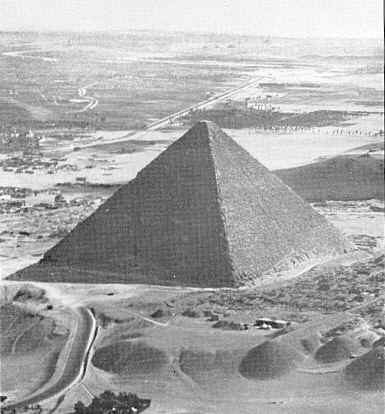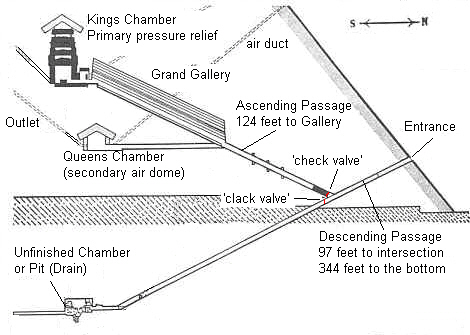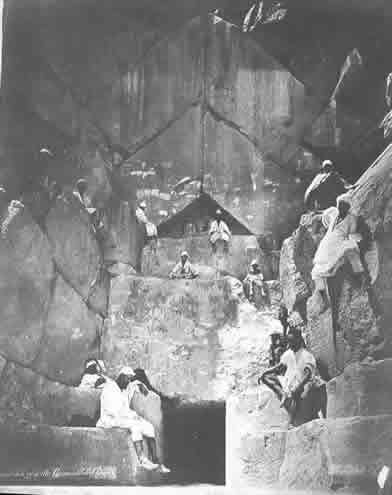 © 2013 Atlas Publications
The Great Pyramids of Eqypt.
© 2013 Atlas Publications
The Great Pyramids of Eqypt.
 Among many other things, they were most probably used to pump drinking water to public fountains in cities above
the flood plain! This was accomplished by having a gigantic ram water pump inside the base of the pyramid.
Configuration and dimensions of the inner chambers could reasonably mean little else....
Among many other things, they were most probably used to pump drinking water to public fountains in cities above
the flood plain! This was accomplished by having a gigantic ram water pump inside the base of the pyramid.
Configuration and dimensions of the inner chambers could reasonably mean little else....
 The Great Pyramid of Giza: awesomely unique, uniquely awesome.
These incredible artifacts of a bygone era have facinated man throughout history. They remain a mystery, both in when and how they were
built, and why. All agree that, even today, we could not possibly build such a supremely awe-inspiring structure.
The Great Pyramid of Giza: awesomely unique, uniquely awesome.
These incredible artifacts of a bygone era have facinated man throughout history. They remain a mystery, both in when and how they were
built, and why. All agree that, even today, we could not possibly build such a supremely awe-inspiring structure.
The civilization that built these pyramids were unique in history. Current research indicates that at its peak there were upwards of
8 million people living in the Nile valley above the flood plain. Considering the land area concerned, this was more densely
populated than Belgium, the highest population density on the planet today!
One can draw quite a few conclusions from even this small amount of information. This area may well have been the
'cradle of civilization', may even have been the basis for the biblical Garden of Eden. One thing is for sure--8 million people did
not walk to the shore of the Nile for their daily water needs, or drag it up from wells by the bucket. Especially if the army of
artisans and multitudes of laborers needed for this project were to be supported! The entire pyramid was cased in pure, white limestone
slabs, highly polished. (long since robbed for building materials). When sunlight fell on it, it is believed that the reflection could
have been seen from the moon, perhaps giving rise to the belief that a 'space beacon' was one of the functions of this gigantic artifact.
The Pyramids--Facts Behind the Myth?
Throughout the course of history, man has looked upon the architectural accomplishments of his ancestors with curiosity and awe; the huge sculptures on Easter Island, England's Stonehenge, and the temples of the South American Incas. The planning and precision craftsmanship required to build these renowned structures is an art that has been lost in time and cannot be duplicated today. Our industrious predecessors have left mankind with more questions than answers, perhaps none more confounding than the mysteries shrouding the ancient civilization of Egypt.
That the Egyptian civilization existed for thousands of years prior to the building of these pyramids and monuments should be without question. The knowledge and foresight necessary for the planning and actual construction of these architectural wonders would have required eons of time to perfect, progressing in concert with the natural evolution of man.
While the age of pyramid building is believed to have commenced in approximately three thousand B.C., the first serious study of ancient Egypt did not occur until the mid 1800s.
The Great Pyramid of Giza stands on the northern edge of the Giza Plateau, located about 10 miles west of Cairo. It is composed of over 2 ˝ million blocks of limestone, which weigh from 2 to 70 tons each. It's base covers over 13 acres and its volume is around 90,000,000 cubic feet.
Exactly how the pyramids were built remains one of history's great mysteries. Scholars tell us that gangs of slaves, as many as forty thousand of them, skilled in masonry and quarrying, tugged the large, perfectly honed building blocks up inclines of sand and rubble over a period of many years.
Each of the four triangular sides slope upward from the base at an angle of 51 degrees 51 minutes and each side has an area of 5 1/2 acres.The joints between adjacent blocks fit together with optical precision and less than a fiftieth of an inch separates the blocks. The cement that was used is extremely fine and strong and defies chemical analysis.
During the reign of Cheops or perhaps his father, Egypt experienced a time of growth. Young men could expect to reach adulthood in the place of their birth, the fertile Nile valley. With the seldomness of war, family life was no doubt largely carefree with an eye toward pleasure and the finer things in life. It was a peaceful time, and with freedom from the constant pressures of defense, builders could afford to construct permanent dwellings with the assurance that present and future generations would share in their enjoyment.
Over a period of thousands of years, the population of man grew in the Nile Valley. Supposition must allow that his intelligence and abilities grew as well. With this population expansion came the paramount need for a central clean, sanitary water supply and distribution system. It is well documented that the inhabitants of this ancient civilization faced an unending battle against the annual flooding of the Nile and subsequent periods of intense and lengthy drought.
Cross sectional drawing of the inner passages and
chambers of the Pyramid as known to date.

Despite seemingly insurmountable obstacles, the resourceful Egyptians devised a grand plan.Their solution to an adequate water supply was to construct masonry structures in the form of four sided pyramids on ground high enough to escape the flood waters. Into the outer structure were incorporated all the astro scientific knowledge they deemed fit, and in the inner structure were incorporated chambers, conduits, valves and plugs constituting a gargantuan hydraulic ram water pump to both purify water and pump it above the flood plain to public fountains in the nearby cities.
exerpt from: 'ALL ABOUT HYDRAULIC RAM PUMPS How and Where They Work ' by D.R.Wilson
The hydraulic ram pump is a reliable, old-time water pump that works just as well today as ever. Often called a water ram or ram, one of these simple devices can pump water from a flowing source of water (spring, creek, river, etc.) to any point above the source, and this without any power requirement except the force of water moving downhill, contained inside a ‘drive pipe‘. A 30-degree angle is ideal. Moving water contains a small amount of kinetic energy (inertia): this is the energy of water falling downhill under the force of gravity, called Fall. The ram pump is constructed to utilize this inertia to pump some of that water to a point highter than the source of water. It runs all the time, requires no fuel, needs only minor periodic maintenence.
Water flows downhill--it is moving. Contained within a pipe ('drive pipe' ) it is incompressable, almost as if it were solid. As far as physics is concerned, it is. Think of a hammer. It weighs so much...but simply laying the head on a nail does no good. Swing the hammer--it is moving. It strikes the nail with far more force than its mere weight. Inertia, object moving, stopped suddenly. Force.
Or think of the old battering ram against the castle gates. Weight of log, movement by warriors, stopped suddenly by the gate. Force. Pillage and looting.
The drive pipe full of water, moving downhill, stopped suddenly by the 'clack' valve closing, Force.. against the 'check valve', opens it against the pressure in the 'high pressure' side of the ram pump. A small amount of that water (about 10%-15%) gets through and eventually ends up at the end-use area.
The Entrance to the Pyramid (or Drive Pipe Intake)

 The entrance to the Great Pyramid is 49 feet above the base. As an intake for the drive pipe for a ram pump, why was it put so high? Well, besides the fact that we're not really sure of the level of the water source back when the pump was operational, most likely it was simply for protection. The source was likely ancient Lake Moeris, in the nearby Libyan Desert, now dried up. The aqueduct feeding water to the pump would need to be elevated for protection from blowing, shifting sand as well as debris, animals or people. There would be a considerable amount of suction at this intake, and debris of any kind would threaten the operation of the pump if drawn in. There was certainly a strainer, filter or sieve of some kind to prevent this--perhaps a thin slab of stone with many holes drilled through it was placed in front of the entrance or intake hole. You can see that the hole was recessed into a rather large alcove-like area. This was probably an area reserved for periodic maintenence, protected from the outside. Perhaps here silt and debris was removed, with a stone gate to shut off the water supply for more thorough cleaning or even a shutdown of the pump.
The entrance to the Great Pyramid is 49 feet above the base. As an intake for the drive pipe for a ram pump, why was it put so high? Well, besides the fact that we're not really sure of the level of the water source back when the pump was operational, most likely it was simply for protection. The source was likely ancient Lake Moeris, in the nearby Libyan Desert, now dried up. The aqueduct feeding water to the pump would need to be elevated for protection from blowing, shifting sand as well as debris, animals or people. There would be a considerable amount of suction at this intake, and debris of any kind would threaten the operation of the pump if drawn in. There was certainly a strainer, filter or sieve of some kind to prevent this--perhaps a thin slab of stone with many holes drilled through it was placed in front of the entrance or intake hole. You can see that the hole was recessed into a rather large alcove-like area. This was probably an area reserved for periodic maintenence, protected from the outside. Perhaps here silt and debris was removed, with a stone gate to shut off the water supply for more thorough cleaning or even a shutdown of the pump.
Intro
NEXT PAGE
Ascending Passage
Grand Gallery & Kings Chamber
Pyramid Pump
This site is a collaboative effort by:
Edward Weaver , amateur Egyptologist and avid Pyramidologist. Ed has studied these ancient civilizations for many years, as well as the idea of a hydraulic structure within the Giza Pyramid. Any comments or questions in these areas are welcomed.
Don Wilson.,
author of All About Hydraulic Ram Pumps has been building, installing and consulting on ram pumps for almost 2 decades. His experiences revealed the functions of the inner chambers and passages of the Great Pyramid as a possible working Hydraulic Ram Water Pump. Any comments or questions in these areas. or on this web site, are welcomed.
Most of the photos in this site were taken from the out of print PYRAMIDOLOGY by Adam Rutherford, and SECRETS OF THE GREAT PYRAMID by Peter Tompkins; also some material from the Giza Pyramid Research site as well as other public domain sources. Much thanks and appreciation to these.

© 2013 Atlas Publications
© 2001 Edward Weaver

 © 2013 Atlas Publications
© 2013 Atlas Publications
 Among many other things, they were most probably used to pump drinking water to public fountains in cities above
the flood plain! This was accomplished by having a gigantic ram water pump inside the base of the pyramid.
Configuration and dimensions of the inner chambers could reasonably mean little else....
Among many other things, they were most probably used to pump drinking water to public fountains in cities above
the flood plain! This was accomplished by having a gigantic ram water pump inside the base of the pyramid.
Configuration and dimensions of the inner chambers could reasonably mean little else.... 


 The entrance to the Great Pyramid is 49 feet above the base. As an intake for the drive pipe for a ram pump, why was it put so high? Well, besides the fact that we're not really sure of the level of the water source back when the pump was operational, most likely it was simply for protection. The source was likely ancient Lake Moeris, in the nearby Libyan Desert, now dried up. The aqueduct feeding water to the pump would need to be elevated for protection from blowing, shifting sand as well as debris, animals or people. There would be a considerable amount of suction at this intake, and debris of any kind would threaten the operation of the pump if drawn in. There was certainly a strainer, filter or sieve of some kind to prevent this--perhaps a thin slab of stone with many holes drilled through it was placed in front of the entrance or intake hole. You can see that the hole was recessed into a rather large alcove-like area. This was probably an area reserved for periodic maintenence, protected from the outside. Perhaps here silt and debris was removed, with a stone gate to shut off the water supply for more thorough cleaning or even a shutdown of the pump.
The entrance to the Great Pyramid is 49 feet above the base. As an intake for the drive pipe for a ram pump, why was it put so high? Well, besides the fact that we're not really sure of the level of the water source back when the pump was operational, most likely it was simply for protection. The source was likely ancient Lake Moeris, in the nearby Libyan Desert, now dried up. The aqueduct feeding water to the pump would need to be elevated for protection from blowing, shifting sand as well as debris, animals or people. There would be a considerable amount of suction at this intake, and debris of any kind would threaten the operation of the pump if drawn in. There was certainly a strainer, filter or sieve of some kind to prevent this--perhaps a thin slab of stone with many holes drilled through it was placed in front of the entrance or intake hole. You can see that the hole was recessed into a rather large alcove-like area. This was probably an area reserved for periodic maintenence, protected from the outside. Perhaps here silt and debris was removed, with a stone gate to shut off the water supply for more thorough cleaning or even a shutdown of the pump.
